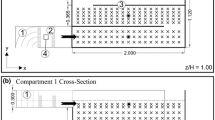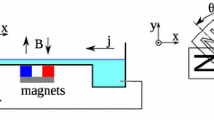Abstract
In variable density, multi-fluid and reacting flows, the degree of molecular mixing is a critical component of turbulent transfer and mixing models. Also, in many microflows and low Reynolds number flows, scalar diffusion length- and time-scales play a significant role in the mixing dynamics. Characterization of such molecular mixing processes requires scalar measurement devices with a small probe volume size. Spatial averaging, which occurs due to finite probe volume size, can lead to errors in resolving the density or scalar gradients between pockets of unmixed fluids. Given a probe volume size and a priori knowledge of the functional profile of the diffusion layer being measured, we obtain an estimate for the measurement error due to spatial averaging and make the corrections accordingly. An analytical model for the measure of scalar mixing is developed as a predictor for the growth of scalar gradients in a variable scalar flow. The model is applied to a buoyancy-driven mixing layer with a Prandtl number of 7. Measurements within the mixing layer have shown that initial entrainment of unmixed fluid causes a decrease in the measured amount of molecular mixing at the centerplane. Following this period of initial entrainment, the fluids within the mixing layer exhibit an increase in the degree of molecular mixing.











Similar content being viewed by others
References
Anuchina NN, Kucherenko YA, Neuvazhaev VE, Ogibina VN, Shibarshov LI, Yakovlev VG (1978) Turbulent mixing at an accelerating interface between liquids of different densities. Izv Akad Nauk SSSR, Mekh Zhidk Gaza 6:157–160
Balmer L (1991) Signals and systems: an introduction. Prentice Hall International Ltd, New York
Boyce WE, DiPrima RC (1997) Elementary differential equations and boundary value problems. Wiley, New York
Broadwell JE, Briedenthal RE (1982) A simple model of mixing and chemical reaction in a turbulent shear layer. J Fluid Mech 125:397–410
Chandrasekhar S (1961) Hydrodynamic and hydromagnetic stability. Dover Publications Inc., New York
Dalziel SB, Linden PF, Youngs DL (1999) Self-similarity and internal structure of turbulence induced by Rayleigh-Taylor instability. J Fluid Mech 399:1–48
Danckwerts PV (1952) The definition and measurement of some characteristics of mixtures. Appl Sci Res 3:279–296
Karasso PS, Mungal MG (1997) Scalar mixing and reaction in plane liquid shear layers. J Fluid Mech 323:23–63
King GF, Dutton JC, Lucht RP (1999) Instantaneous, quantitative measurements of molecular mixing in the axisymmetric jet near field. Phys Fluids 11:403–416
Koochesfahani MM, Dimotakis PE (1986) Mixing and chemical reactions in a turbulent liquid mixing layer. J Fluid Mech 170:83–112
Kukulka DJ (1981) Thermodynamic and transport properties of pure and saline water. MS Thesis, Statue University of New York at Buffalo
Lindl JD (1998) Inertial confinement fusion: the quest for ignition and energy gain using indirect drive. Springer, Berlin Heidelberg New York
Mathematica 5.0 (2005) Wolfram Research, Inc
Meyer TR, Dutton JC, Lucht RP (2001) Experimental study of the mixing transition in a gaseous axisymmetric jet. Phys Fluids 13:3411–3424
Mueschke NJ (2004) An investigation o the influence of initial conditions on Rayleigh-Taylor mixing. M.S. Thesis. Texas A&M University
Ramaprabhu P (2004) On the dynamics of Rayleigh-Taylor mixing. PhD Thesis. Texas A&M University
Ramaprabhu P, Andrews MJ (2004) Experimental investigation of Rayleigh-Taylor mixing at small Atwood numbers. J Fluid Mech 502:233–271
Snider DM, Andrews MJ (1994) Rayleigh-Taylor and shear driven mixing with an unstable thermal stratification. Phys Fluids 6:3324–3334
Wilson PN (2002) A study of buoyancy and shear driven turbulence within a closed water channel. PhD Thesis. Texas A&M University
Wilson PN, Andrews MJ (2002) Spectral measurements of Rayleigh-Taylor mixing at small Atwood number. Phys Fluids 14:938–945
Youngs DL (1984) Numerical Simulation of turbulent mixing by Rayleigh-Taylor instability. Physica D 12:32–44
Youngs DL (1991) Three-dimensional numerical simulation of turbulent mixing by Rayleigh-Taylor instability. Phys Fluids A 3:1312–1320
Acknowledgements
This research was sponsored by the National Nuclear Security Administration under the Stewardship Science Academic Alliances Program through DOE Research Grant no. DE-FG03-02NA00060.
Author information
Authors and Affiliations
Corresponding author
Appendix A
Appendix A
1.1 Evaluation of convolution integral
The evaluation and algebraic simplification of the two convolution integrals in (14) are presented here for completeness. Given the actual scalar
and the measurement probe’s response function
the measured scalar trace is the convolution of the actual scalar value and response function
Both integrals in (3) produce the same result by the commutative property of the convolution (Balmer 1991), thus only the first integral will be evaluated.
Using the definitions of in (30) and (31), (32) can be rewritten as
The integrals can be further divided into
The integral of a constant \(\bar{\phi}\) with ℜ(x) returns the value of the constant \(\bar{\phi}\) because the integral of ℜ(x, R) over −∞ to ∞ is unity. Thus, the ϕ m can be rewritten in a simpler form:
Symbolic integration of the two integrands in (35) were computed using Mathematica (Mathematica 2005):
The integration bounds will now be applied and each equation will be simplified. Starting with the (36),
Noting the following limits
the first integral simplifies to
Combining terms and factoring gives
Applying the integration bounds to the second integral, (37), gives
Using similar limit arguments used in the first integral, the second integral simplifies to
Combining terms and factoring gives
Substituting the results from the simplification of each integral, (41) and (44), into (35) and simplifying, the measured scalar trace becomes
Distributing Δϕ/4 and combining like terms results yields
Replacing the first two terms with ϕ a (x) [see (30)] and letting η a = L a /2R gives the final results shown in (18) and (19):
Rights and permissions
About this article
Cite this article
Mueschke, N.J., Andrews, M.J. Investigation of scalar measurement error in diffusion and mixing processes. Exp Fluids 40, 165–175 (2006). https://doi.org/10.1007/s00348-005-0030-8
Received:
Revised:
Accepted:
Published:
Issue Date:
DOI: https://doi.org/10.1007/s00348-005-0030-8




